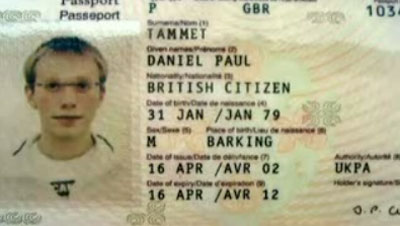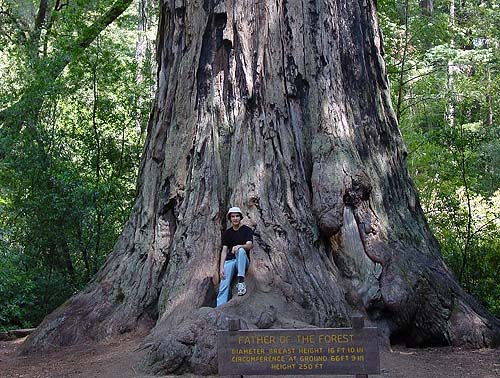Part 1:
Part 2:
Part 3:
Part 4:
Nothing is worse than active ignorance.
Johann Wolfgang von Goethe
Savant syndrome (pronounced /səˈvɑːnt/[1]), sometimes referred to as savantism, is a rare condition in which people with developmental disorders have one or more areas of expertise, ability, or brilliance that are in contrast with the individual's overall limitations. Although not a recognized medical diagnosis, researcher Darold Treffert says the condition may be either genetic or acquired.[2]
Savantism on Wiki


Savant syndrome (pronounced /səˈvɑːnt/[1]), sometimes referred to as savantism, is a rare condition in which people with developmental disorders have one or more areas of expertise, ability, or brilliance that are in contrast with the individual's overall limitations. Although not a recognized medical diagnosis, researcher Darold Treffert says the condition may be either genetic or acquired.[2]
Savantism on Wiki

Daniel Paul Tammet (born 31 January 1979) is a writer with high-functioning autism and savant syndrome. His bestselling 2006 memoir Born On A Blue Day was named a "Best Book for Young Adults" in 2008 by the American Library Association.
Tammet's second book, Embracing the Wide Sky, was named one of France's bestselling books of 2009 by L'Express magazine in its March 2010 edition.
Source
Tallest trees
The heights of the tallest trees in the world have been the subject of considerable dispute and much exaggeration. Modern verified measurements with laser rangefinders, other measuring devices, or with tape drop measurements made by tree climbers (such as those carried out by canopy researchers or members of groups like the U.S. Eastern Native Tree Society), have shown that some older measuring methods and measurements are often unreliable, sometimes producing exaggerations of 5% to 15% or more above the real height.
Historical claims of trees growing to 130 m (427 ft), and even 150 m (492 ft), are now largely disregarded as unreliable, and attributed to human error.
Historical records of fallen trees measured prostrate on the ground are considered to be somewhat more reliable. The following are now accepted as the top ten tallest reliably measured species:
1. Coast Redwood (Sequoia sempervirens): 115.56 m (379.1 ft), Redwood National Park, California, United States
2. Australian Mountain-ash (Eucalyptus regnans): 99.6 m (326.8 ft), south of Hobart, Tasmania, Australia
3. Coast Douglas-fir (Pseudotsuga menziesii): 99.4 m (326.1 ft), Brummit Creek, Coos County, Oregon, United States
4. Philippine rosewood (Petersianthus quadrialatus): 96.9 m (317.9 ft), Agusan del Sur, Mindanao, Philippines (it is possible that it is slightly lower, because the height might include Christmas decorations on the top of the tree)
5. Sitka Spruce (Picea sitchensis): 96.7 m (317.3 ft), Prairie Creek Redwoods State Park, California, United States
6. Giant Sequoia (Sequoiadendron giganteum): 94.9 m (311.4 ft), Redwood Mountain Grove, Kings Canyon National Park, California, United States
7. Tasmanian Blue Gum (Eucalyptus globulus): 90.7 m (297.6 ft), Tasmania, Australia[15]
8. Manna Gum (Eucalyptus viminalis): 89 m (292 ft), Evercreech Forest Reserve, Tasmania, Australia
9. Shorea faguetiana: 88.3 m (289.7 ft) Tawau Hills National Park, in Sabah on the island of Borneo
10. Alpine Ash (Eucalyptus delegatensis): 87.9 m (288.4 ft), Tasmania, Australia Source


Mitchell Lee "Mitch" Hedberg (February 24, 1968 – March 29, 2005) was an American stand-up comedian known for his surreal humor and unconventional comedic delivery. His comedy typically featured short, sometimes one-line jokes, mixed with absurd elements and non sequiturs. Hedberg's comedy and on-stage persona gained him a cult following, with audience members sometimes shouting out the punchlines to his jokes before he could finish them.

Nairobi - Very toxic waste washed on to Somali's coastline by last December's tsumani have spawned diseases bearing symptoms of radioactive exposure in villagers along the shorelines of the shattered African nation, UN Environment Programme said on Friday
"There are reports from villagers of a wide range of medical problems like mouth bleeds, abdominal haemorrhages, unusual skin disorders and breathing difficulties," Nuttall said. UN officials familiar with the situation say the diseases bear radiation sickness symptoms.
Source

Until the late 20th century, ship breaking took place in port cities of industrialized countries such as the United Kingdom and the United States. Today, most ship breaking yards are in Alang in India, Chittagong in Bangladesh, Aliaga in Turkey and Gadani near Karachi in Pakistan, due to lower labor costs and less stringent environmental regulations dealing with the disposal of lead paint and other toxic substances. Some "breakers" still remain in the United States which work primarily on government surplus vessels. There are also some in Dubai, UAE for tankers. China used to be an important player in the 1990s. It is now trying to reposition itself in more environmentally friendly industries.
Ship breaking can occur in a wide variety of facilities. They range from advanced sites like Van Heyghen Recycling and other "Green Ship Recycling" approved facilities in industrialized ports, to low-tech facilities such as at Alang, India. At present the only truly environmentally friendly option is the use of "Green Ship Recycling" at approved facilities. These facilities can recover up to 99% of the ship's materials and correctly process hazardous waste such as asbestos.[1]
Ship Breaking on Wiki
In 1909 Kahn travelled with his chauffeur and photographer, Alfred Dutertre to Japan on business and returned with many photographs of the journey. This prompted him to begin a project collecting a photographic record of the entire Earth. He appointed Jean Brunhes as the project director, and sent photographers to every continent to record images of the planet using the first colour photography, autochrome plates, and early cinematography. Between 1909 and 1931 they collected 72,000 colour photographs and 183,000 meters of film. These form a unique historical record of 50 countries, known as "The Archives of the Planet".
Autochrome was the first industrial process for true colour photography. When the Lumière brothers launched it commercially in June 1907, it was a photograhic revolution - black and white came to life in colour. Autochromes consist of fine layers of microscopic grains of potato starch dyed either red-orange, green or violet blue combined with black carbon particles, spread over a glass plate where it is combined with a black and white photographic emulsion. All colours can be reproduced from three primary colours.Source





Despite the cloudy weather, the flash of light was visible as far as 1,000 kilometers distant, though the sound of the blast would not reach that far for forty-nine minutes, in the form of an indistinct, heavy blow. The giant fireball reached from ground-level to about 34,000 feet into the air, violently releasing 3800 times more explosive energy than the Hiroshima bomb– equivalent to fifty million metric tons of TNT. One hundred kilometers from ground zero the heat would have inflicted third degree burns. Atmospheric focusing produced areas of destruction hundreds of kilometers from ground zero, including wooden structures which were completely destroyed, and some shattered windows in Finland. The explosion’s atmospheric shockwave traveled around the Earth three times before it dissipated.
The mushroom cloud which followed the blast was enormous in scale. It stretched sixty kilometers into the sky, and had a diameter of about forty kilometers. Ionization from the explosion disrupted radio communications for the better part of an hour.
Some time after the explosion, a team was dispatched to ground zero to take photographs. One witness reported: “The ground surface of the island has been levelled, swept and licked so that it looks like a skating rink. The same goes for rocks. The snow has melted and their sides and edges are shiny. There is not a trace of unevenness in the ground… Everything in this area has been swept clean, scoured, melted and blown away.” Analysis of the explosion showed that the area of complete destruction had a radius of twenty-five kilometers from ground zero.
Source
The age of onset is variable, ranging from 35 to 60, with an average of 50. However the disease tends to prominently occur in later years, primarily following childbirth. The disease can be detected prior to onset by genetic testing.[4] Death usually occurs between 7 and 36 months from onset. The presentation of the disease varies considerably from person to person, even among patients from within the same family.
The disease has four stages, taking 7 to 18 months to run its course:
1. The patient suffers increasing insomnia, resulting in panic attacks, paranoia, and phobias. This stage lasts for about four months.
2. Hallucinations and panic attacks become noticeable, continuing for about five months.
3. Complete inability to sleep is followed by rapid loss of weight. This lasts for about three months.
4. Dementia, during which the patient becomes unresponsive or mute over the course of six months. This is the final progression of the disease, resulting in death.
FFI on Wiki
Picture yourself submerged in an ancient sea, 400 million years ago. Above, a large shape appears, gliding powerfully through the water. Its head and trunk are covered with bony plates of armor, and the great, jagged jaws are like a primitive slicing machine, roughly made but clearly effective.
This is Dunkleosteus, one of the first jawed vertebrates, and one of the largest of the armored fishes called placoderms. The fossil record indicates that this fish was an aggressive predator. Some placoderm fossils contain evidence of gouges and scrapes and cuts in the surface of the large bones, matching fairly well to the serrated edges of Dunkleosteus jaw bones; others show that puncture wounds go right through the bones.
The serrated, razor-sharp edges of bones in Dunkleosteus' jaws served as cutting edges. As they rubbed against each other, the opposing jaw blades were like self-sharpening shears. These bones grew continually, regenerating as they were worn down by usage.
Dunkleosteus was undoubtedly a powerful swimmer, much like today's large sharks. Its twenty-foot-long, muscular body ended in a shark-like tail. Its features are clearly those of a predator, and there were plenty of fish to feed on in the Devonian seas. Its prey may well have included primitive sharks, which did not achieve great size and diversity until Dunkleosteus and the other placoderms had disappeared from the oceans. Source

This extinct shark was a monster. Scientists think it may have grown as long as 50 feet (15.25 meters). It could have weighed as much as 50 tons (50,000 kg).
Carcharodon megalodon represents the largest, meat-eating fish to have ever lived. The information we have about its size is drawn from comparisons with living sharks and the relationship between tooth size and total body length. Based on this information we can estimate the overall dimensions of this huge animal. Source



The Kyshtym disaster was a radiation contamination incident that occurred on 29 September 1957 at Mayak, a nuclear fuel reprocessing plant in Russia (then a part of the Soviet Union). It measured as a Level 6 disaster on the International Nuclear Event Scale, making it the second most serious nuclear accident ever recorded (after the Chernobyl disaster). The event occurred in the town of Ozyorsk, a closed city built around the Mayak plant. Since Ozyorsk/Mayak (also known as Chelyabinsk-40 and Chelyabinsk-65) was not marked on maps, the disaster was named after Kyshtym, the nearest known town.
In September 1957 the cooling system in one of the tanks containing about 70–80 tons of radioactive waste failed, and the temperature in it started to rise, resulting in a non-nuclear explosion of the dried waste having a force estimated at about 70–100 tons of TNT, which threw the concrete lid, weighing 160 tons, into the air. There were no immediate casualties as a result of the explosion, which released an estimated 2 to 50 MCi (74 to 1850 PBq ) of radioactivity.
In the next 10 to 11 hours the radioactive cloud moved towards the northeast, reaching 300–350 kilometers from the accident. The fallout of the cloud resulted in a long-term contamination of an area of more than 800 square kilometers, primarily with caesium-137 and strontium-90. This area is usually referred to as the East-Ural Radioactive Trace (EURT).
Because of the secrecy surrounding Mayak, the population of affected areas were not initially informed of the accident. A week later (on 6 October) an operation for evacuating 10,000 people from the affected area started, still without giving an explanation of the reasons for evacuation. People "grew hysterical with fear with the incidence of unknown 'mysterious' diseases breaking out. Victims were seen with skin 'sloughing off' their faces, hands and other exposed parts of their bodies." It was Zhores Medvedev who revealed the nature and extent of the disaster to the world.
Wikipedia
Lake Karachay (Russian: Карача́й), sometimes spelled Karachai, is a small lake in the southern Ural mountains in western Russia. Starting in 1951 the Soviet Union used Karachay as a dumping site for radioactive waste from Mayak, the nearby nuclear waste storage and reprocessing facility, located near the town of Ozyorsk (then called Chelyabinsk-40). According to a report by the Washington, D.C.-based Worldwatch Institute on nuclear waste, Karachay is the most polluted spot on Earth. The lake accumulated some 4.44 exabecquerels (EBq) of radioactivity, including 3.6 EBq of Caesium-137 and 0.74 EBq of Strontium-90. For comparison, the Chernobyl disaster released from 5 to 12 EBq of radioactivity, but this radiation is not concentrated in one location.
The radiation level in the region near where radioactive effluent is discharged into the lake was 600 röntgens per hour in 1990, according to the Washington, D.C.-based Natural Resources Defense Council, more than sufficient to give a lethal dose to a human within an hour. Wikipedia


